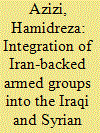| Srl | Item |
| 1 |
ID:
184186


|
|
|
|
|
| Summary/Abstract |
Since 2018, an increasing number of Iran-backed armed groups have started to be integrated into the Syrian and Iraqi official armed forces. The integration of armed groups allows Tehran to enjoy a multi-layered, longer-term, and potentially less expensive influence in Iraq and Syria. Besides, underlying ideological and ideational ties between the armed groups and Iran continue to affect their strategic choices. Meanwhile, and in order to preserve its ability to directly impact the developments, Tehran continues to support an array of smaller militias outside the state structures. This indicates a shifting pattern in Iran’s regional network, from relying predominantly on non-state actors to enjoying a more complex set of non-state and semi-state allies. The consolidation of this model could have considerable implications for Iraq and Syria: 1- Dual loyalties in the Iraqi and Syrian states will make it difficult to form an inclusive government and promote national unity; 2- Anti-American and anti-Israeli ideological elements in the Iraqi and Syrian armed forces’ structure could prevent establishing better ties with the US or Israel; 3- The concern of Iran’s regional rivals over the expansion of Tehran’s influence in Iraq and Syria turns the two countries into a theater for regional confrontations.
|
|
|
|
|
|
|
|
|
|
|
|
|
|
|
|
| 2 |
ID:
144345


|
|
|
|
|
| Summary/Abstract |
This article is intended to serve as a ‘think piece’ which invites readers to view current perceived changes to the conduct of modern warfare in the broader historical light outlined by proponents of epochal change theory. Neo-medievalists have gone a step in this direction and posited that these changes represent the future of warfare and are evidence of a return, in a sense, to the primary tenets of political and social organization that existed in the period commonly referred to as the Middle Ages. The contention herein is that the answer gains more accuracy if one takes a much longer historical standpoint beginning with classical civilization and moving through the medieval period to our modern world. With regard to the present, this epochal warfare analysis projects that a shift from a Westphalian to post-Westphalian global system is underway. During this period of transition – as in the transition periods between epochs which have preceded it – the dominant state form undergoes a deinstitutionalization process, and war is less about traditional issues of state sovereignty, and instead increasingly over ‘what the new form of social and political organization will be’.
|
|
|
|
|
|
|
|
|
|
|
|
|
|
|
|
| 3 |
ID:
175447


|
|
|
|
|
| Summary/Abstract |
The Islamic State (IS) ruled over 11 million people at the height of its power. It also orchestrated over 250 terrorist attacks against the West. Thus, by any measure, IS surpassed the ambitions held by its predecessor al-Qaeda. Yet the United States (US) did not deploy tens of thousands of troops to confront it. It instead used surrogate forces to evict IS from its strongholds. Drawing on interviews with senior policymakers, diplomats, and military officials with knowledge of Operations Inherent Resolve in Syria and Odyssey Lightning in Libya, this paper confronts commonly-held perspectives on the “by, with, through” approach to warfare. It argues that will-to-fight and skillset play important roles in US military partnerships with irregular forces. Nevertheless, these two characteristics alone cannot overcome interference by other nation-states. To be successful, these partnerships should either be limited to short-term objectives or the US and allied forces should be prepared to deter opposition to their surrogates over the medium-to-long term.
|
|
|
|
|
|
|
|
|
|
|
|
|
|
|
|